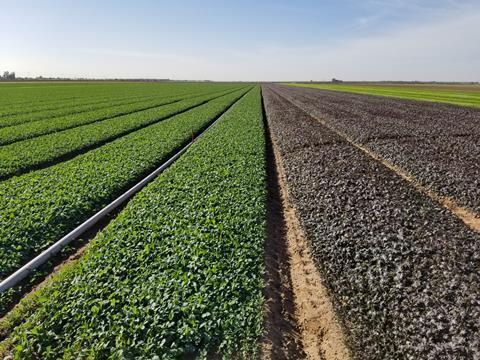
Babyleaf continues to take overall market share in the UK bagged-salad market and is leading the trend in innovation.
A premium product, growers and processors constantly look for new ingredients to make theirs stand out, whether it is adding interest via colour, texture, flavour or simply leaf shape. Helping keep the sector ‘fresh’, Vilmorin North America’s (VNA) pipeline of new varieties offers grower, processor, retailer and consumer benefits.
As John De Soyza of Hazera Seeds, the UK distributor for VNA, explains: “In the past processed bagged product revolved around shredded wholehead lettuce. However, the large cut leaf surfaces lead to oxidation issues impacting on shelf life. Newer multi-leaf varieties proved an improvement, although early varieties tended to have larger leaves requiring two cuts, including a relatively large cut surface at the leaf base. Recently, more compact varieties have entered the market, however leaf size issues often remain when trying to achieve higher head weights. Therein lies a major advantage of babyleaf.
“In addition, non-lettuce options such as spinach, chard, beet, kale and wild rocket have strongly tapered leaves, leading to a narrow stem and small cut surface. The market has experienced strong growth in these,” de Soyza explains. “Combining colour vibrancy with full three-dimensional leaf shape, VNA’s next generation of babyleaf varieties have strongly tapered leaves with a narrow petiole, conferring some of the same advantages as non-lettuce types.”
From an agronomic point of view, with the decreasing availability of fungicides, Bremia is becoming more of a challenge in the field. “This fungus can wipe out a crop,” explains Xavier Etchebarne, VNA babyleaf commercial manager. “Bolting can be a particular challenge with some species such as rocket and with members of the Brassicaceae family, such as kale. Tolerance to these is a key focus of our breeding programmes.”
Processors are looking for varieties exhibiting traits that complement their bagging lines and have superior bag appeal. “New leaf shapes and colours as well as improved shelf life in consumers’ fridges are key traits,” says VNA breeder Charlie Dowling. He goes on to say consumers can be broadly divided into those concerned mostly with taste, colour and shelf life and those primarily focused on nutrition. “Everyone’s taste buds are unique: people like different flavours, varying levels of it and may taste things differently. Others are likely to sacrifice their dislike of a particular flavour, such as the pungency of rocket or kale, for its nutritious value.”
According to De Soyza, Vilmorin breeders are moving the babyleaf project forward into a new era. “We’ve recently trialled and tested a distinctive new red-veined wild rocket (WRX12),” he says. “An improvement over existing types, the striking red veins provide a sharp and clear contrast to the green highly incised leaves.”
For the traditional wild rocket sector, there is promising newcomer SSC3110. “Unlike standard types producing a rounded first flush of leaves, it produces the easily recognisable incised rocket shape from the start,” he explains.
“Quicker to grow and with a much milder flavour, salad rocket is less strong and peppery and our new innovation, SCC2970, has a striking red vein and beautifully green incised leaf.”
Offering a signature hot flavour, existing ‘wasabi’ rocket varieties are prone to bolting. “You can lose the crop if you’re not keeping an eye on it,” says Dowling. “We have a new variety (SSC3112) offering improved bolting tolerance and a more consistent leaf shape, while still producing the distinctive wasabi flavour.”
Among babyleaf lettuce varieties, Vilmorin has a new Red Tango (200176). “Giving an explosion of cherry red colour, it has an exceptionally voluminous leaf that tapers to a narrow petiole, which is ideal for processing,” explains De Soyza. “The market is desperate for Bremia-resistant varieties. Uniquely among this type, our new Red Tango and new Green Tango (BVP111819) both offer full BL16-35 resistance.”
Meanwhile in the Russian kale sector, the new eye-catching and iron-rich KX1 is overtaking the sector in the US market, while demand in the UK, France, Spain and Italy grows steadily.
“It’s hugely popular with growers in the Salinas Valley in California and Yuma in Arizona, where the majority of US salad is grown,” says Dowling. “With a wine-red coloured leaf and green underside, it is a really unique product and also benefits from downy mildew tolerance. KX2 is another one to watch out for in the future; it offers the same distinctive shape but is green.”
De Soyza believes bok choi is a segment currently underutilised for babyleaf. “Bok choi offers consistent red-coloured leaves all season, even in low light levels when some lettuce varieties struggle with leaves turning brown,” he explains. “Our new red bok choi, BC 16-004, delivers a vibrant intense red colour season long and demonstrates good field holding.”
For the eye-catching Mizuna sector Vilmorin has two promising and visually interesting newcomers – MX13 (green) and MX11 (red). Both have highly incised leaves, similar to Origami, but with better colour offering vibrant colour to a salad mix while giving growers great field holding.
Looking to the future, De Soyza says: “As with other crop types, Hazera is looking to increase local screening and selection. Innovative distinct colour and shape as well as improved shelf life and eating quality are key targets. Ideally growers want varieties that remain compact, produce a small cut surface and consistent even colour.”



